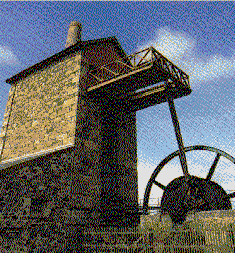|
You
may wonder why Cornwall had the mineral mines that the rest of Britain
missed out on. There is a simple geological explanation. During the
late stages of the cooling of the mass of granite that makes up a lot
of Cornwall, fissures opened up in the granite when it was still
molten, and more hot molten rocks bubbled up through the granite from
the earth's interior. These new rocks contained many minerals, and as
they crystallized they formed mineral lodes - tin, copper, zinc, lead
and iron with some silver. Because the ore bearing rocks formed in this
way, rather than being sedimentary rocks like coal (hence coal is laid
down in great flat plates), they have to be mined vertically rather
than horizontally. Each fissure has to be mined straight down into the
earth. Each fissure needed a separate mine. Therefore a great many
vertical shafts were needed, rather than the one shaft that was used in
coal mining.
Inevitably
the mine shafts dropped below the level of the water table, and the
water had to be pumped out if mining was to continue any deeper. Hence
pumps and the houses for the engines that drove the pumps were a
necessary part of mining. These engine houses were the sturdiest
buildings in the mines, as they had both to house the machinery and
support the massive beams that worked the pumps. It is not surprising
that it is the engine houses that survive in Cornwall. In addition the
closer to sea level the engine was sited, the less the height the water
needed to be pumped to remove it from the mine. Therefore we find today
some of these engine house perched on the sea cliffs.
Coal
is not native to Cornwall, so it had to be imported, by ship, to keep
the engines in steam. Getting coal to the engines was in itself a
difficult and expensive operation. Water was sometimes used to power
waterwheels, but suitable rivers were not plentiful either in Cornwall.
There
were no other substantial buildings in a typical mine. Given that many
of the mines were small and vertical, they did not invest in cages to
haul the miners up and down, instead access to the mine was by ladder,
a tiring part of the daily toil of the miners. And of course the
Cornish Pasty was used originally by the miners as their food
underground. It was easy to carry, and could have savory in one end and
sweet in the other.
Mining
existed here from the days of stone age man, but it was in the 19th
century that mining reached its zenith, before foreign competition
depressed the price of copper and later tin, to a level that made
Cornish ore unprofitable. At its height, the Cornish Tin Mining
Industry had around 600 steam engines working to pump out the mines.
During the 20th century various ores became briefly profitable, and
mines were reopened, but today none remain. The collapse of the world
tin cartel in 1986 being the last nail in the coffin of tin mining.
Source- Camborne School of Mines

|

